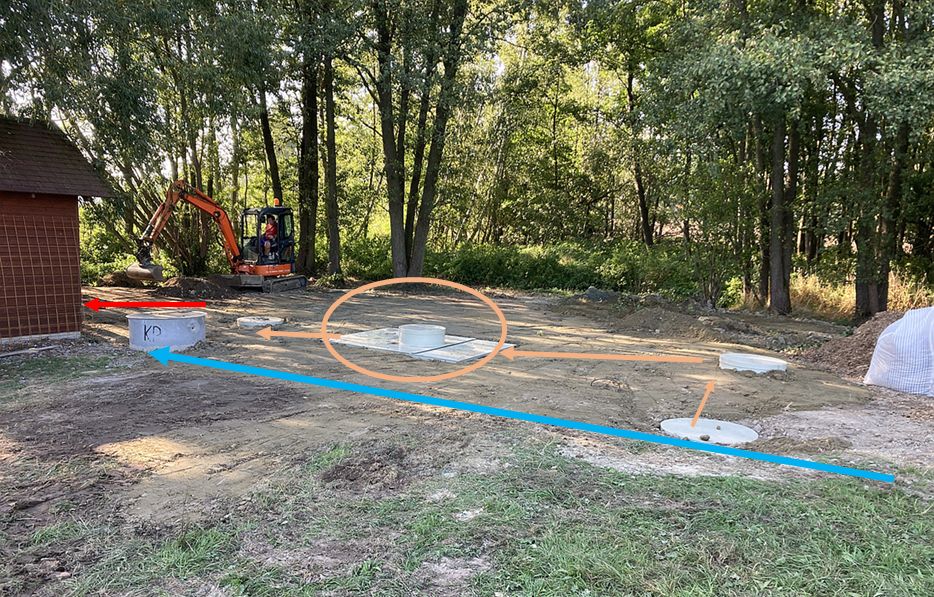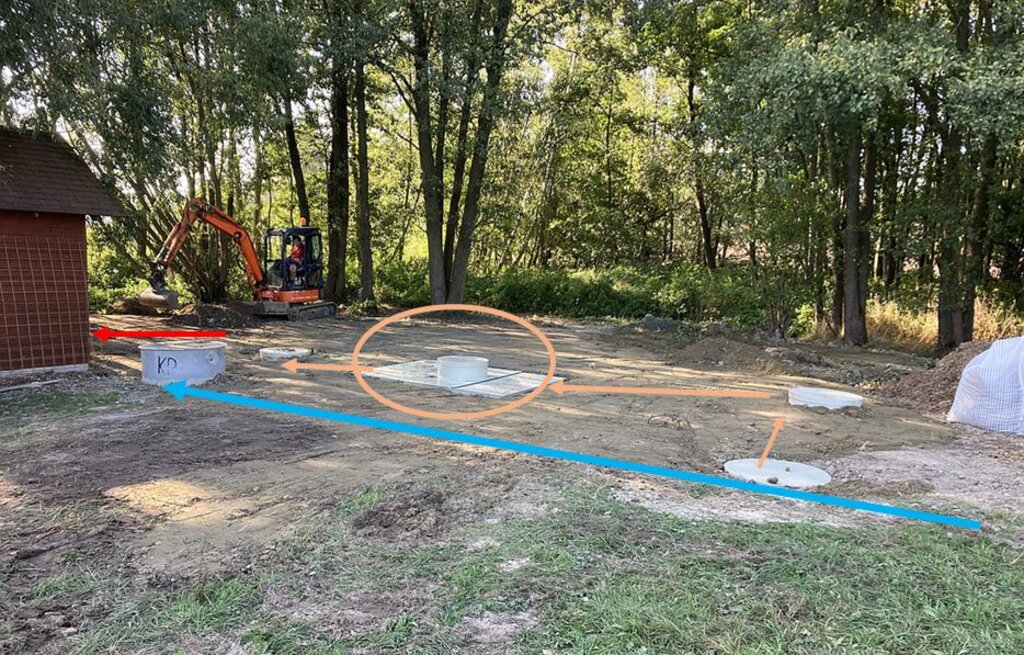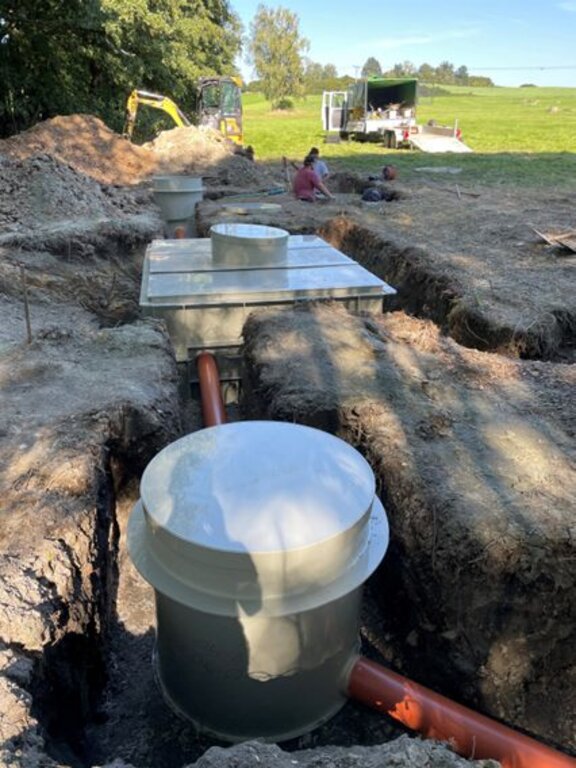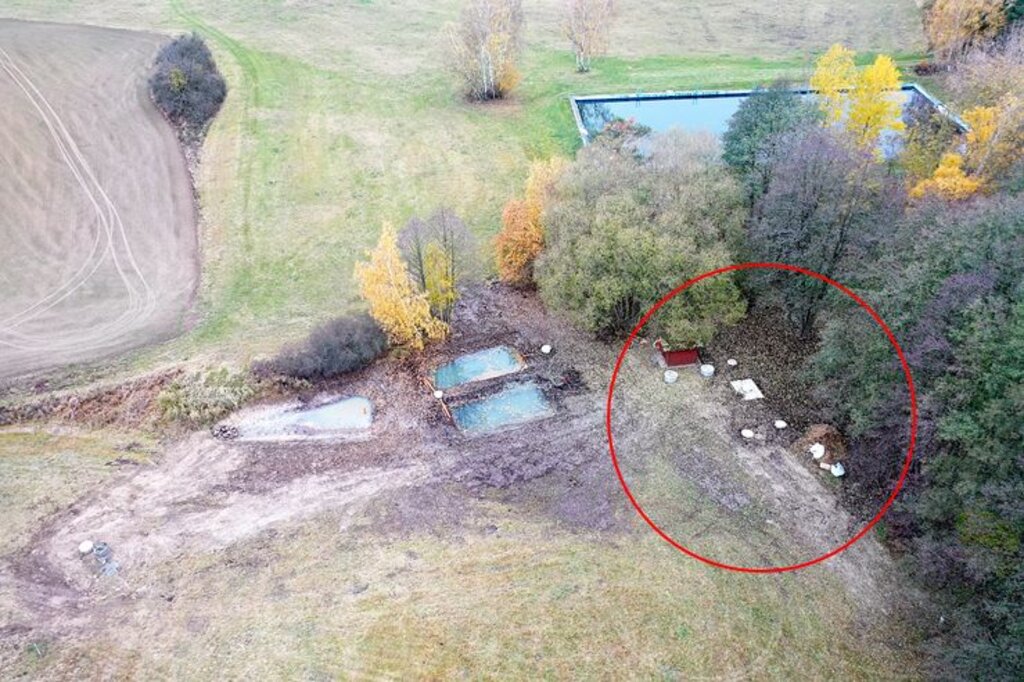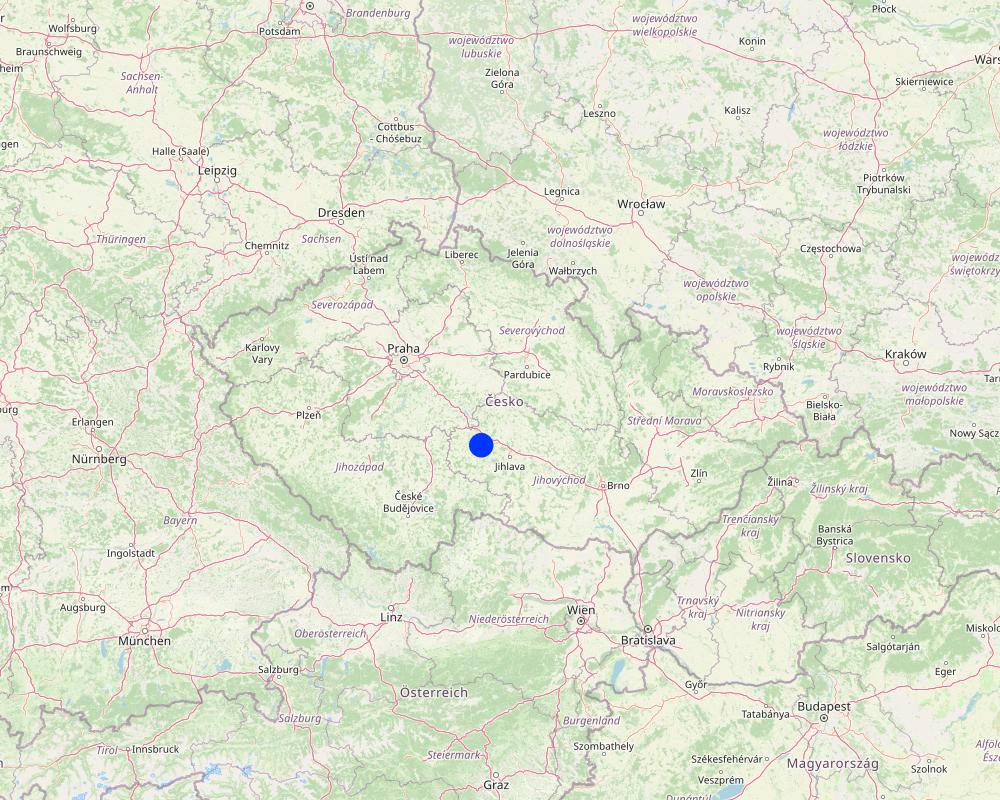Drainage Biofilter [Czech Republic]
- Creation:
- Update:
- Compiler: Antonín Zajíček
- Editor: –
- Reviewers: William Critchley, Rima Mekdaschi Studer
Drenážní biofiltr
technologies_6259 - Czech Republic
View sections
Expand all Collapse all1. General information
1.2 Contact details of resource persons and institutions involved in the assessment and documentation of the Technology
Name of project which facilitated the documentation/ evaluation of the Technology (if relevant)
OPtimal strategies to retAIN and re-use water and nutrients in small agricultural catchments across different soil-climatic regions in Europe (OPTAIN)Name of project which facilitated the documentation/ evaluation of the Technology (if relevant)
Approaches for design and realization of complex effective measures for tile drained agricultural catchments by land consolidations (QK21010341) {'additional_translations': {}, 'value': 6269, 'label': 'Name of the institution(s) which facilitated the documentation/ evaluation of the Technology (if relevant)', 'text': 'Research Institute for Soil and Water Conservation (VUMOP) - Czech Republic', 'template': 'raw'}1.3 Conditions regarding the use of data documented through WOCAT
The compiler and key resource person(s) accept the conditions regarding the use of data documented through WOCAT:
Yes
1.4 Declaration on sustainability of the described Technology
Is the Technology described here problematic with regard to land degradation, so that it cannot be declared a sustainable land management technology?
No
Comments:
The advantage of the drainage biofilter is that it occupies only a relatively small area and only minimally impedes soil cultivation
1.5 Reference to Questionnaire(s) on SLM Approaches (documented using WOCAT)
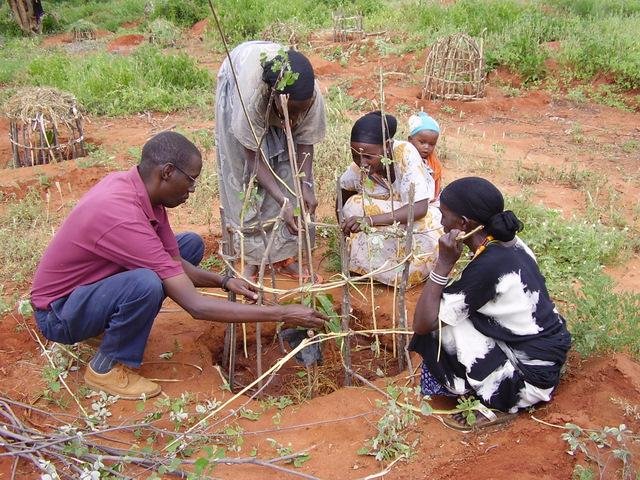
Catchment Approach [Kenya]
A focused approach to integrated land and water management, including soil and water conservation, where the active participation of the villagers - often organised through common interest groups - is central.
- Compiler: James Gatero Njuki
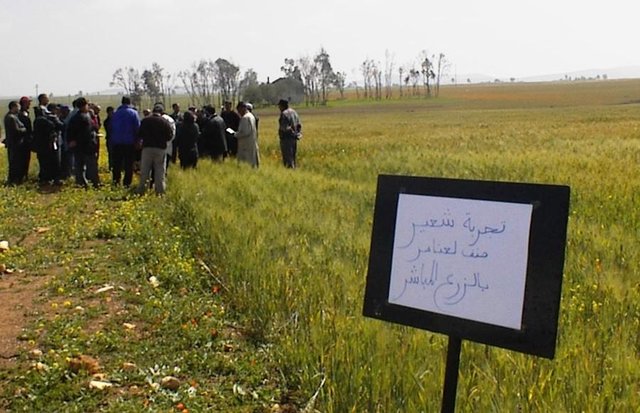
Applied research and knowledge transfer [Morocco]
Innovative, cross-disciplinary community-based approach for development and transfer of no-till technology at the farm level.
- Compiler: Rachid Mrabet
2. Description of the SLM Technology
2.1 Short description of the Technology
Definition of the Technology:
Biofilters or “bioreactors” connected to agricultural tile drains are relatively inexpensive and space-saving measures with considerable potential to improve the quality of drainage water.
2.2 Detailed description of the Technology
Description:
A biofilter or “bioreactor” is a relatively small installation used to break down pollutants from drainage water. Its basic function is to allow the passage of drainage water, contaminated with nutrients and pesticides, through a container with pollutant-reducing agents. Bioreactors are usually located at the bottom of agricultural drainage structures on the drains or in connection with drainage outlets. Ideally, the biofilter is located on a site that is no longer part of the cultivated land or is under permanent grassland.
In principle, two biofilter solutions are possible. In the case of low and regular drainage flows, the drainage section is directly replaced by a biofilter. With higher flows and in the case of rapid response of the drainage structure to rainfall-runoff episodes, the biofilter is placed parallel to the outlet drain or is located under the drainage outlet (if ambient conditions allow). Such a design includes a distribution structure (preferably located in a drainage manhole) and a drainage pipe to allow safe bypassing of a portion of the elevated drainage outlet, to maintain the residence time of the water in the biofilter and thus its corresponding efficiency.
The biofilter may be designed as closed or open. A closed biofilter is completely buried and normal tillage can take place. An open biofilter lacks the advantage of an undisturbed terrain but has the advantage of benefitting from plants that enhance the purification of drainage water by bacteria living on their roots.
The installation always consists of a bed or container in which the reducing agent is enclosed, ensuring the isolation of the agent from the surrounding soil and water. In the case of a smaller sized closed biofilter, a plastic container can be used, while in the case of a larger or open design, plastic film can be used as a bed. Various materials can be used as biofilter fillings, or substrates, both individually and in combination. In most cases, the reducing agent is carbonaceous, with denitrification mediated by chemo-organotrophic bacteria.
In terms of N-NO3 removal, the most effective are wood chips, which have a high hydraulic conductivity and a C:N ratio of 30:1 to 300:1. In particular, chips from poplar, pine and larch are suitable. For the removal of pesticides or biopharmaceuticals, then biochar (biochar) and lignite are suitable as natural and readily available materials. A combination of materials can also be used. For example, the addition of biochar to the wood chips will increase the efficiency of the bioreactor in degrading pesticides, or the charge can be combined with an inorganic substrate (sand, vermiculite), which is added to prevent undesirable settling, reduce hydraulic conductivity and at the same time mechanically purify the drainage water.
2.3 Photos of the Technology
2.5 Country/ region/ locations where the Technology has been applied and which are covered by this assessment
Country:
Czech Republic
Region/ State/ Province:
Vysočina region (Highlands Region)
Further specification of location:
Černičí, Dehtáře
Specify the spread of the Technology:
- applied at specific points/ concentrated on a small area
Is/are the technology site(s) located in a permanently protected area?
No
Map
×2.6 Date of implementation
If precise year is not known, indicate approximate date:
- less than 10 years ago (recently)
2.7 Introduction of the Technology
Specify how the Technology was introduced:
- during experiments/ research
- through projects/ external interventions
Comments (type of project, etc.):
Several biofilters have already been implemented as part of research projects, and the development of a standardized, efficient and easy-to-implement solution is currently underway.
3. Classification of the SLM Technology
3.1 Main purpose(s) of the Technology
- protect a watershed/ downstream areas – in combination with other Technologies
- preserve/ improve biodiversity
- reduce diffusive agricultural pollution
3.2 Current land use type(s) where the Technology is applied
Land use mixed within the same land unit:
No

Cropland
- Perennial (non-woody) cropping
Perennial (non-woody) cropping - Specify crops:
- fodder crops - grasses
Number of growing seasons per year:
- 1
Is intercropping practiced?
No
Is crop rotation practiced?
No

Waterways, waterbodies, wetlands
- Drainage lines, waterways
3.3 Has land use changed due to the implementation of the Technology?
Has land use changed due to the implementation of the Technology?
- Yes (Please fill out the questions below with regard to the land use before implementation of the Technology)

Cropland
- Annual cropping
Annual cropping - Specify crops:
- cereals - barley
- cereals - maize
- cereals - wheat (winter)
- oilseed crops - sunflower, rapeseed, other
- root/tuber crops - potatoes
Is intercropping practiced?
Yes
If yes, specify which crops are intercropped:
In some seasons, spring cereal mix, legume-cereal mix or undersown clover is used as an intercrop
Is crop rotation practiced?
Yes
If yes, specify:
five-years or seven-years crop rotation containinng winter cereals, spring cereals, potatoes, red clover, oil seed rape and maize
3.4 Water supply
Water supply for the land on which the Technology is applied:
- rainfed
3.5 SLM group to which the Technology belongs
- surface water management (spring, river, lakes, sea)
- ground water management
3.6 SLM measures comprising the Technology

vegetative measures
- V2: Grasses and perennial herbaceous plants

structural measures
- S11: Others
3.7 Main types of land degradation addressed by the Technology

water degradation
- Hp: decline of surface water quality
- Hq: decline of groundwater quality
3.8 Prevention, reduction, or restoration of land degradation
Specify the goal of the Technology with regard to land degradation:
- not applicable
Comments:
This measure is primarily aimed at improving water quality.
4. Technical specifications, implementation activities, inputs, and costs
4.1 Technical drawing of the Technology
Technical specifications (related to technical drawing):
The drawing shows a closed biofilter/bioreactor system, which is built as a bypass of the existing drainage pipe. The measure is looped at the bottom of the drainage system to approximate the recipient.
This system consists mainly of the following features:
1) Drainage water inlet - existing drainage pipe - tile drains
2) Flow control facillity, which is built on top of the existing drainage pipe. The main line structure was excavated, the original ceramic pipe was replaced with a plastic PP pipe and a manhole with an embedded baffle was inserted to allow the water to rise to the required level and subsequently overflow the excess water over the overflow edge. A control element is placed in the manhole to regulate the flow of water into the system.
3) The existing drain, which, once the measures are constructed, serves as a bypass for excess runoff during spring thaw or significant rainfall-runoff episodes.
4) Inflow to the biofilter in the form of a newly constructed pipe.
5) Bed of biofilter - a hardened bed to prevent destruction of the biofilter by shallow groundwater levels and a plastic container for the actual biofilter fill.
6) Biofilter fill. I.n this case a mixture of vermiculite, wood chips and biochar, alternatively wood chips themselves or other materials can be used
7) Purified water outlet from the biofilter
8) Flow control facility, built in drainage manhole, purified water is returned to the existing drainage pipe
9) Drainage outlet
Author:
Research Institute for Soil and Water Conservation
Date:
01/02/2023
4.2 General information regarding the calculation of inputs and costs
Specify how costs and inputs were calculated:
- per Technology unit
Specify unit:
measure - one system of closed biofilter/bioreactor
other/ national currency (specify):
EUR
If relevant, indicate exchange rate from USD to local currency (e.g. 1 USD = 79.9 Brazilian Real): 1 USD =:
0.92
Indicate average wage cost of hired labour per day:
150
4.3 Establishment activities
| Activity | Timing (season) | |
|---|---|---|
| 1. | Selecting proper place for the measure | Before implementation |
| 2. | Obtaining the consent of the owners and users of the affected land | Before implementation |
| 3. | Project documentation | Before implementation |
| 4. | Water management office permisiond and building permission | Before implementation |
| 5. | Excavation works | Drier period, ideally at the end of the growing season |
| 6. | Biofilter construction | Drier period, ideally at the end of the growing season |
| 7. | Filling the biofilter with substrates | Drier period, ideally at the end of the growing season |
4.4 Costs and inputs needed for establishment
| Specify input | Unit | Quantity | Costs per Unit | Total costs per input | % of costs borne by land users | |
|---|---|---|---|---|---|---|
| Labour | Project/design | person-days | 5.0 | 200.0 | 1000.0 | 100.0 |
| Labour | Engineering | person-days | 10.0 | 200.0 | 2000.0 | 100.0 |
| Labour | Implementation of the measure | person-days | 6.0 | 150.0 | 900.0 | 100.0 |
| Equipment | Tansport of material | machine-days | 5.0 | 150.0 | 750.0 | 100.0 |
| Equipment | Excavation works | machine-days | 3.0 | 220.0 | 660.0 | 100.0 |
| Plant material | grasss seeding | kg | 10.0 | 8.0 | 80.0 | 100.0 |
| Construction material | Distribution object (manhole) | piece | 2.0 | 2200.0 | 4400.0 | 100.0 |
| Construction material | Container for filling the biofilter | piece | 1.0 | 2400.0 | 2400.0 | 100.0 |
| Construction material | Sorbents (vermukulit, biochar, woodchips) | m3 | 3.0 | 440.0 | 1320.0 | 100.0 |
| Construction material | drainage pipes and other material | m | 20.0 | 2.0 | 40.0 | 100.0 |
| Total costs for establishment of the Technology | 13550.0 | |||||
| Total costs for establishment of the Technology in USD | 14728.26 | |||||
If land user bore less than 100% of costs, indicate who covered the remaining costs:
co-financing from public sources
Comments:
Under certain conditions, owners and users of land, regardless of their legal form, municipalities and other public entities may apply for a subsidy for the implementation of this measure, which is provided by the Ministry of the Environment of the Czech Republic
The subsidy is up to 100 % of the total eligible expenditure, the minimum eligible direct implementation expenditure per project is set at CZK 250 000 ( 10 000 EUR), excluding VAT.
4.5 Maintenance/ recurrent activities
| Activity | Timing/ frequency | |
|---|---|---|
| 1. | Exchange of reducing agent in biofilter | every 5 - 10 years |
| 2. | Cutting the grass aroun the measure | twice a year |
| 3. | Checking and maintenance/repairs | once a year |
4.6 Costs and inputs needed for maintenance/ recurrent activities (per year)
| Specify input | Unit | Quantity | Costs per Unit | Total costs per input | % of costs borne by land users | |
|---|---|---|---|---|---|---|
| Labour | grass chopper | machine days | 1.0 | 100.0 | 100.0 | 100.0 |
| Plant material | grasss seed | kg | 10.0 | 8.0 | 80.0 | 100.0 |
| Total costs for maintenance of the Technology | 180.0 | |||||
| Total costs for maintenance of the Technology in USD | 195.65 | |||||
Comments:
It is necessary to replace the sorbent once every 5 years to once every 10 years. The price of sorbents (vermiculite, biochar, woodchips) EUR 1320 for ca 3 cubic meters needed. The price for transportation and switching of old and new sorbents is ca EUR 300.
4.7 Most important factors affecting the costs
Describe the most determinate factors affecting the costs:
The price of this measure is mostly influenced by its dimensioning for a certain water residence time of the drainage runoff (the above described example is dimensioned for a delay period of about 12 hours at a maximum drainage flow of 0.5 l/s). Another factor is the price of sorbents, where biochar and vermiculite in particular are quite expensive (approximately 250 EUR/m3). Alternatively, woodchips can be used (80 EUR/m3). The price can also be reduced by a simpler construction of the biofilter bed. The minimum price for this measure is estimated at EUR 3 200.
5. Natural and human environment
5.1 Climate
Annual rainfall
- < 250 mm
- 251-500 mm
- 501-750 mm
- 751-1,000 mm
- 1,001-1,500 mm
- 1,501-2,000 mm
- 2,001-3,000 mm
- 3,001-4,000 mm
- > 4,000 mm
Specify average annual rainfall (if known), in mm:
666.00
Specifications/ comments on rainfall:
Total precipitation during the vegetation
period ranges between 350 and 450 mm, and in the
winter months between 250 and 300 mm, with a total annual
average of 666 mm.
Indicate the name of the reference meteorological station considered:
Košetice, own measurement
Agro-climatic zone
- sub-humid
mean average temperature 7,9 °C
5.2 Topography
Slopes on average:
- flat (0-2%)
- gentle (3-5%)
- moderate (6-10%)
- rolling (11-15%)
- hilly (16-30%)
- steep (31-60%)
- very steep (>60%)
Landforms:
- plateau/plains
- ridges
- mountain slopes
- hill slopes
- footslopes
- valley floors
Altitudinal zone:
- 0-100 m a.s.l.
- 101-500 m a.s.l.
- 501-1,000 m a.s.l.
- 1,001-1,500 m a.s.l.
- 1,501-2,000 m a.s.l.
- 2,001-2,500 m a.s.l.
- 2,501-3,000 m a.s.l.
- 3,001-4,000 m a.s.l.
- > 4,000 m a.s.l.
Indicate if the Technology is specifically applied in:
- convex situations
Comments and further specifications on topography:
The altitude varies between 549.8 and 497 m asl., The substrate is formed by partially
migmatized paragneiss in various degrees of degradation.
Quaternary sediments are represented by slope sands and
loams reaching 1–2 m thickness.
5.3 Soils
Soil depth on average:
- very shallow (0-20 cm)
- shallow (21-50 cm)
- moderately deep (51-80 cm)
- deep (81-120 cm)
- very deep (> 120 cm)
Soil texture (topsoil):
- medium (loamy, silty)
Soil texture (> 20 cm below surface):
- medium (loamy, silty)
- fine/ heavy (clay)
Topsoil organic matter:
- medium (1-3%)
If available, attach full soil description or specify the available information, e.g. soil type, soil PH/ acidity, Cation Exchange Capacity, nitrogen, salinity etc.
The representation of soils
(according to the World Reference Base for Soil Resources
2006) is variable, with Gleyed Cambisols, Gleysols, and
sporadically Histosols. In the recharge area, the soil cover is
more homogenous, with prevailing Modal, Ranker and
Arenic Cambisols.
5.4 Water availability and quality
Ground water table:
< 5 m
Availability of surface water:
good
Water quality (untreated):
for agricultural use only (irrigation)
Water quality refers to:
both ground and surface water
Is water salinity a problem?
No
Is flooding of the area occurring?
No
Comments and further specifications on water quality and quantity:
Water quality is threatened by non-point source (agricultural) pollution, in particular by increased leaching of nitrate nitrogen and pesticides and their metabolites
5.5 Biodiversity
Species diversity:
- medium
Habitat diversity:
- medium
5.6 Characteristics of land users applying the Technology
Sedentary or nomadic:
- Sedentary
Market orientation of production system:
- commercial/ market
Off-farm income:
- less than 10% of all income
Relative level of wealth:
- average
- rich
Individuals or groups:
- cooperative
- employee (company, government)
Level of mechanization:
- mechanized/ motorized
Gender:
- women
- men
Age of land users:
- youth
- middle-aged
- elderly
5.7 Average area of land used by land users applying the Technology
- < 0.5 ha
- 0.5-1 ha
- 1-2 ha
- 2-5 ha
- 5-15 ha
- 15-50 ha
- 50-100 ha
- 100-500 ha
- 500-1,000 ha
- 1,000-10,000 ha
- > 10,000 ha
Is this considered small-, medium- or large-scale (referring to local context)?
- medium-scale
Comments:
The Czech Republic is characterised by a significant size of agricultural holdings. During the socialist era (1948-1989), large agricultural cooperatives were established. Today, most agricultural land is still farmed by similar enterprises, whether in the form of cooperatives, limited liability companies or joint stock companies.
5.8 Land ownership, land use rights, and water use rights
Land ownership:
- company
- communal/ village
Land use rights:
- leased
- individual
Water use rights:
- open access (unorganized)
Are land use rights based on a traditional legal system?
No
5.9 Access to services and infrastructure
health:
- poor
- moderate
- good
education:
- poor
- moderate
- good
technical assistance:
- poor
- moderate
- good
employment (e.g. off-farm):
- poor
- moderate
- good
markets:
- poor
- moderate
- good
energy:
- poor
- moderate
- good
roads and transport:
- poor
- moderate
- good
drinking water and sanitation:
- poor
- moderate
- good
financial services:
- poor
- moderate
- good
6. Impacts and concluding statements
6.1 On-site impacts the Technology has shown
Ecological impacts
Water cycle/ runoff
water quantity
Comments/ specify:
Slowing of the drainage runoff will be noticeable especially during normal and lower discharges
water quality
Comments/ specify:
The effects of the measures are particularly positive in terms of reducing nutrient (nitrogen, phosphorus) and pesticide concentrations
6.2 Off-site impacts the Technology has shown
groundwater/ river pollution
Comments/ specify:
The effect of biofilter-type measures is particularly pronounced in small intensively drained agricultural catchments where much of the runoff (and pollution) comes from drainage waters
6.3 Exposure and sensitivity of the Technology to gradual climate change and climate-related extremes/ disasters (as perceived by land users)
Other climate-related consequences
Other climate-related consequences
| How does the Technology cope with it? | |
|---|---|
| Irregular rainfall distribution and increasing number of runoff episodes | moderately |
Comments:
A sudden increase in drainage flow during a rainfall-runoff episode may cause a short-term reduction in the effectiveness of the measures, whereby the residence time of water in the biofilter may be reduced and also a portion of the drainage runoff flows untreated through the bypass
6.4 Cost-benefit analysis
How do the benefits compare with the establishment costs (from land users’ perspective)?
Short-term returns:
slightly negative
Long-term returns:
slightly positive
How do the benefits compare with the maintenance/ recurrent costs (from land users' perspective)?
Short-term returns:
neutral/ balanced
Long-term returns:
neutral/ balanced
6.5 Adoption of the Technology
- single cases/ experimental
6.6 Adaptation
Has the Technology been modified recently to adapt to changing conditions?
Yes
other (specify):
treating of pesticide pollution
Specify adaptation of the Technology (design, material/ species, etc.):
The use of biochar and other advanced materials as substrates will enable the use of bioreactors to reduce water pollution from pesticides and their metabolites
6.7 Strengths/ advantages/ opportunities of the Technology
| Strengths/ advantages/ opportunities in the land user’s view |
|---|
| Relatively small and cheap measure |
| The measure does not require frequent and costly maintenance |
| Strengths/ advantages/ opportunities in the compiler’s or other key resource person’s view |
|---|
| High efficiency of drainage water treatment measures |
6.8 Weaknesses/ disadvantages/ risks of the Technology and ways of overcoming them
| Weaknesses/ disadvantages/ risks in the land user’s view | How can they be overcome? |
|---|---|
| Difficult to obtain subsidies for construction | Change in subsidy polices |
| Often different owner and user of the land concerned |
| Weaknesses/ disadvantages/ risks in the compiler’s or other key resource person’s view | How can they be overcome? |
|---|---|
| Reduced efficiency during significant rainfall-runoff events | Correct sizing of the measure. |
7. References and links
7.1 Methods/ sources of information
- field visits, field surveys
Long term research of the whole team
- interviews with land users
Discussion with several dozen farmers
- interviews with SLM specialists/ experts
Literature searches of scientific articles
When were the data compiled (in the field)?
2016
7.2 References to available publications
Title, author, year, ISBN:
ZAJÍČEK, A., SYCHRA, L., VYBÍRAL, T., HEJDUK, T., ČMELÍK, M., FUČÍK, P., KAPLICKÁ, M. 2021: Design of the Revitalization measures on the Main drainage facilities and hydrologically related Detailed drainage facilities (In Czech)
Available from where? Costs?
https://doi.org/10.3390/w15061247
Title, author, year, ISBN:
Kvítek, T.; Zajíček, A.; Dostál, T.; Fučík, P.; Krása, J.; Bauer, M.; Jáchymová, B.; Kulhavý, Z.; Pavel, M. Slowing Down Quick Runoff—A New Approach for the Delineation and Assessment of Critical Points, Contributing Areas, and Proposals of Measures to Reduce Non-Point Water Pollution from Agricultural Land. Water 2023, 15, 1247.
Available from where? Costs?
https://doi.org/10.3390/w15061247
Title, author, year, ISBN:
Vrchovecká, S., Asatiani, N., Antoš, V., Wacławek, S., Hrabák, P. (2023): et al. Study of Adsorption Efficiency of Lignite, Biochar, and Polymeric Nanofibers for Veterinary Drugs in WWTP Effluent Water. Water Air Soil Pollut 234, 268.
Available from where? Costs?
https://doi.org/10.1007/s11270-023-06281-0
Title, author, year, ISBN:
Johnson, G. M.,Christianson, R. D., Cooke, R.A. C., Diaz-Garcia, C., Christianson, L. E. 2022. Denitrifying bioreactor woodchip sourcing guidance based on physical and hydraulic properties. ECOLOGICAL ENGINEERING, 184
Available from where? Costs?
DOI10.1016/j.ecoleng.2022.106791
Title, author, year, ISBN:
Christianson, LE et al., 2021. EFFECTIVENESS OF DENITRIFYING BIOREACTORS ON WATER POLLUTANT REDUCTION FROM AGRICULTURAL AREAS,AGRICULTURAL ENGINEERINGAGRICULTURAL ENGINEERING
Available from where? Costs?
DOI10.13031/trans.14011
7.3 Links to relevant online information
Title/ description:
Zajíček, A., Hejduk, T., Sychra, L., Vybíral, T., Fučík, P. (2022): How to Select a Location and a Design of Measures on Land Drainage – A Case Study from the Czech Republic. Journal of Ecological Engineering 2022, 23(4), 43–57. ISSN 2299–8993.
URL:
https://doi.org/10.12911/22998993/146270
Links and modules
Expand all Collapse allLinks

Catchment Approach [Kenya]
A focused approach to integrated land and water management, including soil and water conservation, where the active participation of the villagers - often organised through common interest groups - is central.
- Compiler: James Gatero Njuki

Applied research and knowledge transfer [Morocco]
Innovative, cross-disciplinary community-based approach for development and transfer of no-till technology at the farm level.
- Compiler: Rachid Mrabet
Modules
No modules


